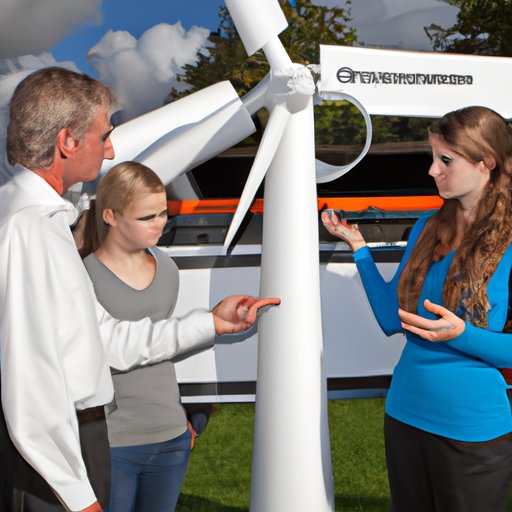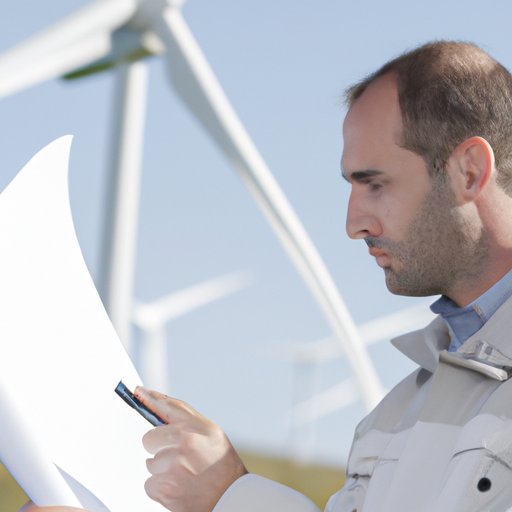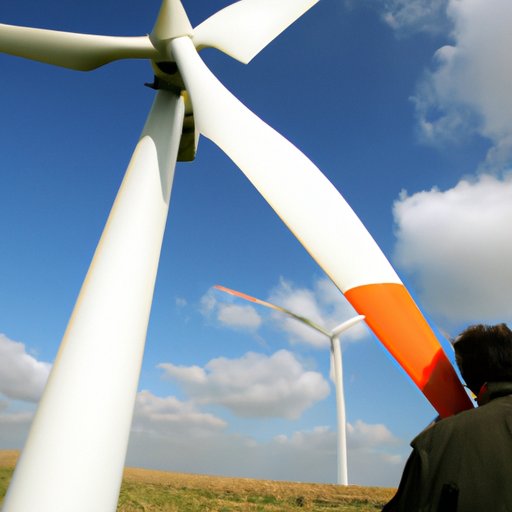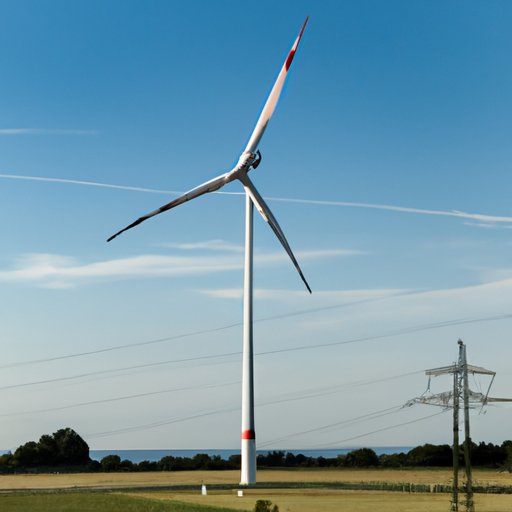Introduction
A wind turbine is a device that converts kinetic energy from the wind into mechanical energy. This mechanical energy can then be used to generate electricity or be used for other purposes such as pumping water. Wind turbines have become increasingly popular in recent years as an alternative source of renewable energy. They are typically seen in large groups known as “wind farms” located in areas with high winds. In this article, we will explore how does a wind turbine work, examining the components and mechanics behind wind energy.

Explaining the Components of a Wind Turbine and How They Work Together
A wind turbine consists of several main components that work together to generate energy. The components include blades, a nacelle, a gearbox, and a generator. Each component plays an important role in the functioning of the turbine.
Blades
The blades are the most visible part of a wind turbine and serve as the primary mechanism for capturing the wind’s energy. The shape and size of the blades are designed to capture the most amount of wind possible while keeping the structure stable. The blades rotate in the wind, creating a torque which causes the rotor to spin. Depending on the design of the turbine, the blades can either be horizontal or vertical.
Nacelle
The nacelle is the housing that contains the gearbox and generator. It is usually located directly behind the blades and is connected to the rotor. The nacelle is designed to protect the internal components from the harsh environment outside.
Gearbox
The gearbox is responsible for transferring the mechanical energy from the rotor to the generator. It works by increasing the speed of the rotation of the rotor to match the speed of the generator. This allows for more efficient energy transfer and also reduces wear and tear on the internal components.
Generator
The generator is the component that converts the mechanical energy from the gearbox into electrical energy. It is typically a three-phase AC induction motor that uses magnets and coils to generate electricity.
An Overview of the Mechanics Behind Wind Turbines
Now that we’ve looked at the components of a wind turbine, let’s take a look at the mechanics behind how they work. As mentioned before, the blades are the primary mechanism for capturing the wind’s energy. When the wind blows, the blades are forced to rotate due to the aerodynamic lift created by the wind.
The Role of the Blades
The shape and size of the blades play an important role in the efficiency of the turbine. According to research conducted by the University of Nebraska-Lincoln, “The blade shape affects the lift coefficient and thereby the power generated by the wind turbine.” 1 The blades are designed to capture the most amount of wind possible while minimizing drag and turbulence. This helps to maximize the efficiency of the turbine.
Energy Conversion Process
Once the wind has been captured by the blades, the energy is transferred to the rotor which is connected to the gearbox. The gearbox increases the speed of the rotor to match the speed of the generator. The generator then converts the mechanical energy into electrical energy which can be used to power homes and businesses.

Examining the Efficiency of Wind Turbines
Efficiency is an important factor when it comes to assessing the effectiveness of a wind turbine. The efficiency of a turbine is determined by its ability to convert wind energy into usable electrical energy. Let’s take a look at some of the factors that affect a turbine’s efficiency and how it is measured.
Factors Affecting Efficiency
The efficiency of a wind turbine is affected by several factors including the type of turbine, the size of the turbine, the location of the turbine, and the wind speed. For example, larger turbines tend to be more efficient than smaller turbines due to their increased surface area and better aerodynamics. Additionally, turbines located in areas with higher wind speeds tend to be more efficient than those located in areas with lower wind speeds.
Measuring Efficiency
The efficiency of a wind turbine is typically measured by its “capacity factor”. The capacity factor is the ratio of the actual energy produced by the turbine to the theoretical maximum energy that could be produced under ideal conditions. Generally speaking, a higher capacity factor indicates a more efficient turbine.

Investigating How Wind Turbines Generate Electricity
Now that we’ve discussed the components of a wind turbine and the factors affecting its efficiency, let’s take a look at how wind turbines actually generate electricity. There are two main types of systems used to generate electricity from wind turbines – direct-drive systems and indirect-drive systems.
Direct-Drive Systems
Direct-drive systems use a direct connection between the rotor and the generator. This eliminates the need for a gearbox and reduces the amount of maintenance required. Direct-drive systems are typically more efficient than indirect-drive systems but are also more expensive.
Indirect-Drive Systems
Indirect-drive systems use a gearbox to transfer the energy from the rotor to the generator. This system is less efficient than a direct-drive system but is also less expensive. Indirect-drive systems are typically used in small-scale applications such as residential wind turbines.
Comparing Different Types of Wind Turbines
When looking at different types of wind turbines, there are two main categories – horizontal axis turbines and vertical axis turbines. Each type has its own advantages and disadvantages which should be considered when selecting the right turbine for your application.
Horizontal Axis vs. Vertical Axis
Horizontal axis turbines are the most common type of wind turbine and are typically used in large-scale applications such as wind farms. These turbines have blades that rotate around a horizontal axis and are more efficient than vertical axis turbines. Vertical axis turbines have blades that rotate around a vertical axis and are typically used in small-scale applications such as residential turbines. They are less efficient than horizontal axis turbines but are also less expensive.
Small vs. Large Turbines
Small turbines are typically used in residential applications and have a capacity of up to 100 kW. They are less efficient than large turbines but are also much less expensive. Large turbines are typically used in commercial applications and have a capacity of up to 5 MW. They are more efficient than small turbines but are also much more expensive.
Conclusion
In conclusion, wind turbines are an increasingly popular source of renewable energy. By understanding the components and mechanics behind wind turbines, we can better understand how they work and how they can be used to generate electricity. We’ve examined the components of a wind turbine, explored the mechanics behind how they work, and compared different types of turbines. We’ve also looked at the factors that affect the efficiency of a wind turbine and how it is measured. By utilizing wind energy, we can reduce our dependence on fossil fuels and help to protect the environment.
(Note: Is this article not meeting your expectations? Do you have knowledge or insights to share? Unlock new opportunities and expand your reach by joining our authors team. Click Registration to join us and share your expertise with our readers.)
